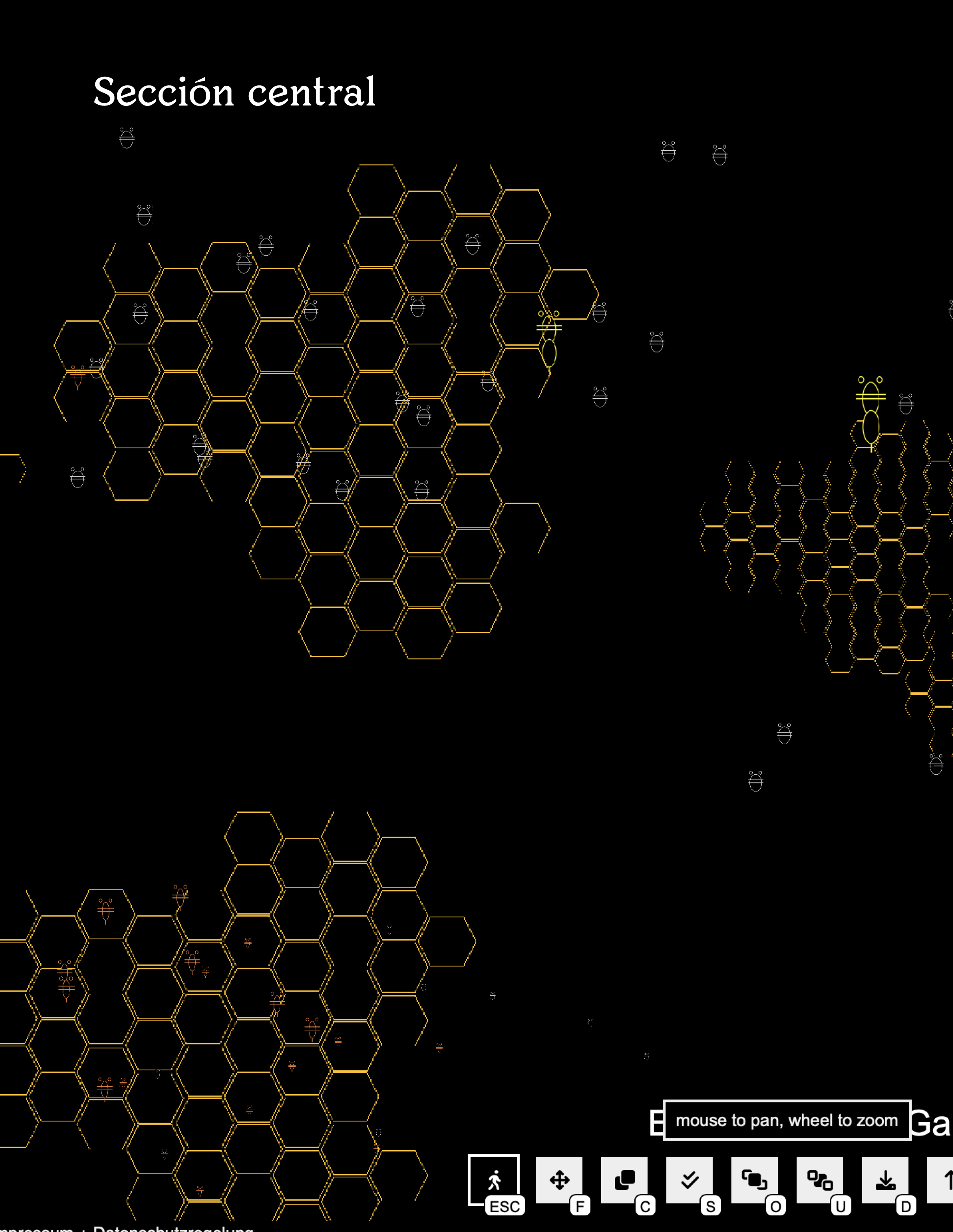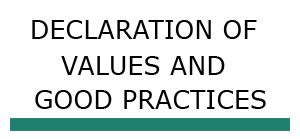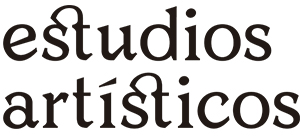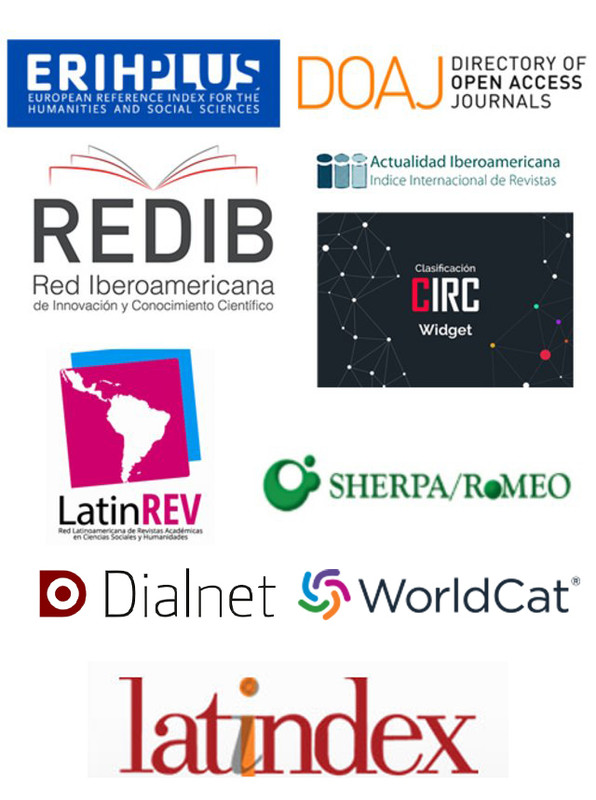
DOI:
https://doi.org/10.14483/25009311.22346Publicado:
2024-07-28Edição:
v. 10 n. 17 (2024): Julio-diciembre 2024Seção:
Sección CentralZumbido Digital. Explorando el bio arte con un ecosistema de abejas virtuales
Digital Buzz. Exploring bio art with a virtual bee ecosystem
Buzz digital. Explorando a bioarte com um ecossistema de abelhas virtuais
Palavras-chave:
Bio Arte, Arte y Vida Artificial, Ecosistema Digital, Simulación Biológica, Nota, Space (es).Palavras-chave:
Bio Art, Art and Artificial Life, Digital Ecosystem, Biological Simulation, Nota, Space (en).Palavras-chave:
Bio Arte, Arte e Vida Artificial, Ecossistema Digital, Simulação Biológica, nota, Space (pt).Downloads
Resumo (es)
El proyecto Zumbido Digital: Explorando el bio arte con un ecosistema de abejas virtuales." combina el arte, la entomología y la tecnología para crear un ecosistema digital que simula el comportamiento de las abejas. Desarrollado en la plataforma nota.space y galardonado con el NOTANEAR AWARDS en el International Digitalkunst Festival de Stuttgart 2022, el proyecto de investigación – creación se basa en estudios entomológicos detallados de la morfología, locomoción y hábitat de las abejas. Utilizando algoritmos de caminata aleatoria y técnicas de programación orientada a objetos, se simularon los roles de abeja reina, obreras y zánganos. El prototipo de programación está orientado hacia una futura investigación sobre la simulación de ecosistemas digitales y sistemas autoorganizados, destacando la capacidad del bio arte para explorar la interactividad digital y las propiedades emergentes.
Resumo (en)
The project "Digital Buzz: Exploring Bio Art with a Virtual Bee Ecosystem" combines art, entomology, and technology to create a digital ecosystem simulating bee behavior. Developed on the nota.space platform and awarded the NOTANEAR AWARD at the International Digitalkunst Festival in Stuttgart 2022, the research-creation project is based on detailed entomological studies of bee morphology, locomotion, and habitat. Using random walk algorithms and object-oriented programming techniques, roles of queen bees, workers, and drones were simulated. The programming prototype is oriented towards future research on simulating digital ecosystems and self-organized systems, highlighting the capacity of bio art to explore digital interactivity and emergent properties. traduce esto al portugues
Resumo (pt)
O projeto "Digital Buzz: Explorando a bioarte com um ecossistema de abelhas virtuais" combina arte, entomologia e tecnologia para criar um ecossistema digital que simula o comportamento das abelhas. Desenvolvido na plataforma nota.space e premiado com os PRÊMIOS NOTAnEAR no Festival Internacional Digitalkunst em Stuttgart 2022, o projeto de pesquisa-criação é baseado em estudos entomológicos detalhados da morfologia, locomoção e habitat das abelhas. Usando algoritmos de caminhada aleatória e técnicas de programação orientada a objetos, os papéis das abelhas rainhas, operárias e drones foram simulados. O protótipo de programação é voltado para pesquisas futuras sobre a simulação de ecossistemas digitais e sistemas auto-organizados, destacando a capacidade da bioarte de explorar a interatividade digital e propriedades emergentes.
Referências
Bartlem, E. (2005). Immersive artificial life (A‐life) art. Journal of Australian Studies, 28(84), pp. 95-107.
Berg, H. C. (1983). Random Walks in Biology. Princeton University Press.
Codling, E. A., Plank, M. J., & Benhamou, S. (2008). Random walk models in biology. Journal of the Royal Society Interface, 5(25), 813-834. https://doi. org/10.1098/rsif.2008.0014pp. 813-834. https://doi. org/10.1098/rsif.2008.0014
Conway, J. (1970). The game of life. Scientific American, 223(4), 4.
Dorin, A. (2008). A survey of virtual ecosystems in generative electronic art. In The art of artificial evolution: A handbook on evolutionary art and music (pp. 289-309). Berlin, Heidelberg: Springer Berlin Heidelberg.
Estudios Artísticos: revista de investigación creadora
Ewens, W. J. (2004). Mathematical Population Genetics. Springer.
Fama, E. F. (1965). The behavior of stock-market prices. The Journal of Business, 38(1), pp. 34-105. https://doi.org/10.1086/294743
Feller, W. (1968). An Introduction to Probability Theory and Its Applications, Vol. 1. Wiley.
García Oliver, M. Á. (2012). Complejidad y Modelado Basado en Agentes. Una aproximación a los ecosistemas virtuales en el A-Life Art.
Gooding Sánchez, L. F. (2018). Del suspiro en el alba hasta el abrazo en el ocaso: Una composición evolutiva. Espacio Sonoro, 46, pp. 1-7.
Sánchez Gooding, L. F., y García Borbón, E. J. (2018). Simbiosis: Composición para bandola andina colombiana y entidades sónicas. Estudios Artísticos, 4(4), 88–109. https://doi.org/10.14483/25009311.12935
Grimaldi, D., & Engel, M. S. (2005). Evolution of the Insects. Cambridge University Press.
Grinstead, C. M., & Snell, J. L. (2012). Introduction to Probability. American Mathematical Society.
Gullan, P. J., & Cranston, P. S. (2014). The Insects: An Outline of Entomology. Wiley-Blackwell.
Hernández, I., & Niño, R. (2010). Estética, vida artificial y biopolítica. Expansiones en la evolución cultural y biológica a través de la tecnología.
Izhikevich, E. M., Conway, J. H., & Seth, A. (2015). Game of life. Scholarpedia, 10(6), p. 1816.
Kimura, M. (1983). The Neutral Theory of Molecular Evolution. Cambridge University Press.
Lawler, G. F., & Limic, V. (2010). Random walk: a modern introduction, Vol. 123. Cambridge University Press.
Lem, S. (2002). Solaris. United Kingdom: Harcourt Brace & Company.
Malkiel, B. G. (1973). A Random Walk Down Wall Street. W. W. Norton & Company.
McCormack, J. (1993). Interactive evolution of L-system grammars for computer graphics modelling. Complex Systems: from biology to computation, 2.
McCormack, J. (2008). Evolutionary L-systems. In Design by evolution: Advances in evolutionary design (pp. 169-196). Berlin, Heidelberg: Springer Berlin Heidelberg.
Nota.Space. (n.d.). About. Recuperado de «https://nota.space»
Ohlenschlager, K., Weibel, P., & Weidinger, A. (Eds.). (2023). Christa Sommerer & Laurent Mignonneau: The Artwork as a Living System 1992-2022. MIT Press.
Padua, D., & Padua, D. (2021). The digital ecosystem. Digital Cultural Transformation: Building Strategic Mindsets via Digital Sociology, pp. 89-136.
Penny, S. (2010). Twenty years of artificial life art. Digital Creativity, 21(3), pp. 197-204.
Schrödinger, E. (1944). What is life? The physical aspect of the living cell.
Service, M. W. (2012). Medical Entomology for Students. Cambridge University Press.
Snodgrass, R. E. (1935). Principles of Insect Morphology. McGraw-Hill.
Speight, M. R., Hunter, M. D., & Watt, A. D. (2008). Ecology of Insects: Concepts and Applications. Wiley-Blackwell.
Triplehorn, C. A., & Johnson, N. F. (2005). Borror and DeLong's Introduction to the Study of Insects. Cengage Learning.
Wu, Z. W., Qu, H., & Zhang, K. (2024). A survey of recent practice of Artificial Life in visual art. Artificial Life, 30(1), pp. 106-135.
Xenakis, I. (1992). Formalized Music: Thought and Mathematics in Composition. Hillsdale, NJ: Pendragon Press
Como Citar
APA
ACM
ACS
ABNT
Chicago
Harvard
IEEE
MLA
Turabian
Vancouver
Baixar Citação
Licença
Copyright (c) 2024 Estudios Artísticos

Este trabalho está licenciado sob uma licença Creative Commons Attribution-NonCommercial-ShareAlike 4.0 International License.
Licencia actual vigente
Creative Commons BY NC SA - Atribución – No comercial – Compartir igual. Vigente a partir del Vol. 8 Núm. 13 (2022)
https://creativecommons.org/licenses/by-nc-sa/4.0/deed.e
Licencias anteriores
Desde el Vol. 5 Núm. 6 (2019) hasta el Vol. 8 Núm. 12 (2022) se utilizó la licencia Creative Commons 4.0 https://creativecommons.org/licenses/by/4.0/
Desde el Vol 1 Num 1 (2015) hasta el Vol 4 Núm 4 (2018) la licencia Creative Commons utilizada fue Reconocimiento- Nocomercial-Sin obras derivadas 2.5 Colombia https://creativecommons.org/licenses/by/2.5/co/
POLÍTICA DE PLAGIO
La Revista ESTUDIOS ARTÍSTICOS expone las directrices sobre buenas prácticas en la publicación científica, como marco para el desarrollo y la implementación de sus propias políticas y sistema de ética en la publicación. Los Editores de la Revista ESTUDIOS ARTÍSTICOS , seleccionan los revisores bajo unas directrices de imparcialidad y profesionalidad, a fin de que se puedan asegurar evaluaciones justas, los Editores garantizan a los autores que se seleccionan a los revisores apropiados para las revisiones de sus trabajos, y los lectores puedan confiar en el proceso de revisión por pares.
Los Editores de ESTUDIOS ARTÍSTICOS son conscientes del trabajo necesario para la toma de decisiones firmes y la creación de procesos editoriales sólidos, diseñados para gestionar sus intereses y fomentar un sistema de publicación eficiente y sostenible, que beneficiará a las instituciones académicas, a los editores de revistas, a los autores, a quienes financian la investigación y a los lectores. Las buenas prácticas en la publicación científica, no se desarrollan espontáneamente sino que se establecen conscientemente y se promueven activamente.
Responsabilidades de los autores de los trabajos
Todos los autores que se reflejan en el trabajo deben haber contribuido activamente en el mismo.
ESTUDIOS ARTÍSTICOS proporciona a los autores unas instrucciones claras donde se explican los conceptos de autoría académica, especificando que las contribuciones deben quedar claras. Los editores de ESTUDIOS ARTÍSTICOS piden la declaración a los autores de que cumplen con los criterios de la revista en relación a la autoría. En caso de darse un conflicto en la autoría de un trabajo publicado, los Editores de ESTUDIOS ARTÍSTICOS se pondrán en contacto con el autor que reclama su autoría para establecer la veracidad del caso. Si los Editores lo estiman oportuno, se cerrará el acceso temporalmente al artículo en cuestión, hasta que se tome una decisión final.
Los documentos a publicar, no deben haber sido publicados antes
ESTUDIOS ARTÍSTICOS considerará sólo aquellos trabajos que no hayan sido publicados antes en otra Editorial y en cualquier formato. En este sentido, se considera que la literatura científica puede ser sesgada por una publicación redundante, con consecuencias importantes. ESTUDIOS ARTÍSTICOS pide a los autores que una declaración de que la obra presentada, sobre todo en su comunicación esencial, no ha sido publicada antes, y no está siendo considerada para su publicación en otros envíos
Los Editores de ESTUDIOS ARTÍSTICOS tienen derecho a exigir un trabajo original y cuestionar los autores acerca de si los artículos de opinión (por ejemplo, editoriales, cartas, revisiones no sistemáticas) han sido publicados antes.
Promover la integridad de la investigación
La mala conducta de Investigación
Si los Editores de ESTUDIOS ARTÍSTICOS sospechan de una mala conducta en la investigación llevada a cabo en un trabajo (por ejemplo, la generación de datos, falsificación o plagio), consultarán a los autores del trabajo sobre el procedimiento desarrollado para la investigación y estos deberán proporcionar cuanta información se les solicite.
La revisión por pares a veces puede detectar indicios de mala conducta en la investigación, en estos casos, los revisores plantearán sus dudas y de ser confirmadas, se considerarán como una falta grave (por ejemplo, la fabricación de datos, la falsificación, la manipulación de imágenes inapropiadas o plagio). No obstante, en todo caso los autores tienen derecho a responder a esas denuncias y demostrar que las investigaciones se han llevado a cabo con diligencia y con la velocidad adecuada.
La protección de los derechos de los participantes / sujetos de investigación
Los Editores de ESTUDIOS ARTÍSTICOS trabajan para crear políticas de publicación que promuevan prácticas éticas y responsables de investigación. Se buscarán garantías de que los estudios han sido aprobados por los organismos pertinentes. Si en la investigación se ha trabajado con datos de personas, los trabajos resultantes, deben ir acompañados de una declaración de consentimiento por parte de las mismas. Los Editores se reservan el derecho a rechazar el trabajo si hay dudas acerca de si se han seguido los procedimientos adecuados.
El respeto de las culturas y el patrimonio
Los Editores de ESTUDIOS ARTÍSTICOS expresan su sensibilidad a la hora de publicar imágenes de objetos que podrían tener un significado cultural o ser causa de delito.
Informar a los lectores acerca de la investigación y la publicación de la mala conducta
Los Editores advertirán a los lectores si se han producido violaciones éticas. En estos casos, ESTUDIOS ARTÍSTICOS publicará las oportunas correcciones cuando estos errores puedan afectar a la interpretación de los datos y a la información, cualquiera que sea la causa del error. Del mismo modo, ESTUDIOS ARTÍSTICOS publicará un escrito de rectificación si se ha demostrado que el trabajo puede ser fraudulento, o si los Editores tienen sospechas fundadas de que se ha desarrollado la investigación bajo una mala conducta. En este caso, la revista publicará una corrección como fe de erratas o la rectificación que incluirá las palabras "Fe de erratas" o "Corrección", se publicará en una página numerada y aparecerá en el índice de contenidos de la revista. Esta rectificación permitirá al lector identificar y entender la corrección en el contexto de los errores cometidos, o explicará por qué se corrigió del artículo, o recogerá las preocupaciones del Editor sobre el contenido del artículo. Estará vinculado electrónicamente con la publicación electrónica original.









